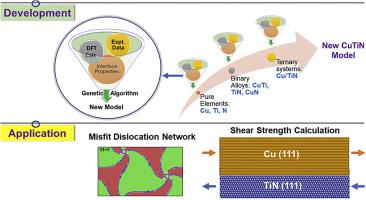当前位置:
X-MOL 学术
›
Mater. Des.
›
论文详情
Our official English website, www.x-mol.net, welcomes your feedback! (Note: you will need to create a separate account there.)
Development and application of interatomic potentials to study the stability and shear strength of Ti/TiN and Cu/TiN interfaces
Materials & Design ( IF 8.4 ) Pub Date : 2020-11-01 , DOI: 10.1016/j.matdes.2020.109123 Abu Shama Mohammad Miraz , Nisha Dhariwal , W.J. Meng , Bala R. Ramachandran , Collin D. Wick
Materials & Design ( IF 8.4 ) Pub Date : 2020-11-01 , DOI: 10.1016/j.matdes.2020.109123 Abu Shama Mohammad Miraz , Nisha Dhariwal , W.J. Meng , Bala R. Ramachandran , Collin D. Wick

|
Abstract A modified embedded atom method interatomic potential was developed to study semi-coherent metal/ceramic interfaces involving Cu, Ti and N. A genetic algorithm was used to fit the model parameters to the physical properties of the materials. To accurately describe interfacial interactions and shear, two-dimensional generalized stacking fault energy profiles for relevant slip systems were selected as one of the major parameterization targets for the models. The models were applied to study semi-coherent Ti(0001)/TiN(111) and Cu(111)/TiN(111) systems. Ti/TiN was stable with misfits accommodated away from the interface. Cu/TiN, in contrast, was more stable with misfits at the interface. A spiral pattern in the misfit dislocation networks was observed away from the Cu/TiN interface, similar to the metal/metal (111) semi-coherent interfaces. The theoretical shear strength calculated for Ti/TiN when the misfits were several layers away from the interface and for Cu/TiN with the misfit at the chemical interface, had reasonable agreement with experiment.
中文翻译:

原子间势的发展和应用在研究 Ti/TiN 和 Cu/TiN 界面的稳定性和剪切强度
摘要 为了研究涉及Cu、Ti、N的半相干金属/陶瓷界面,开发了一种改进的嵌入原子方法原子间势。使用遗传算法将模型参数拟合到材料的物理性质。为了准确描述界面相互作用和剪切,相关滑动系统的二维广义堆垛层错能量分布被选为模型的主要参数化目标之一。该模型被应用于研究半相干 Ti(0001)/TiN(111) 和 Cu(111)/TiN(111) 系统。Ti/TiN 是稳定的,在远离界面的地方有错配。相比之下,Cu/TiN 在界面失配时更稳定。在远离 Cu/TiN 界面处观察到错配位错网络中的螺旋图案,类似于金属/金属 (111) 半相干界面。
更新日期:2020-11-01
中文翻译:

原子间势的发展和应用在研究 Ti/TiN 和 Cu/TiN 界面的稳定性和剪切强度
摘要 为了研究涉及Cu、Ti、N的半相干金属/陶瓷界面,开发了一种改进的嵌入原子方法原子间势。使用遗传算法将模型参数拟合到材料的物理性质。为了准确描述界面相互作用和剪切,相关滑动系统的二维广义堆垛层错能量分布被选为模型的主要参数化目标之一。该模型被应用于研究半相干 Ti(0001)/TiN(111) 和 Cu(111)/TiN(111) 系统。Ti/TiN 是稳定的,在远离界面的地方有错配。相比之下,Cu/TiN 在界面失配时更稳定。在远离 Cu/TiN 界面处观察到错配位错网络中的螺旋图案,类似于金属/金属 (111) 半相干界面。



























 京公网安备 11010802027423号
京公网安备 11010802027423号